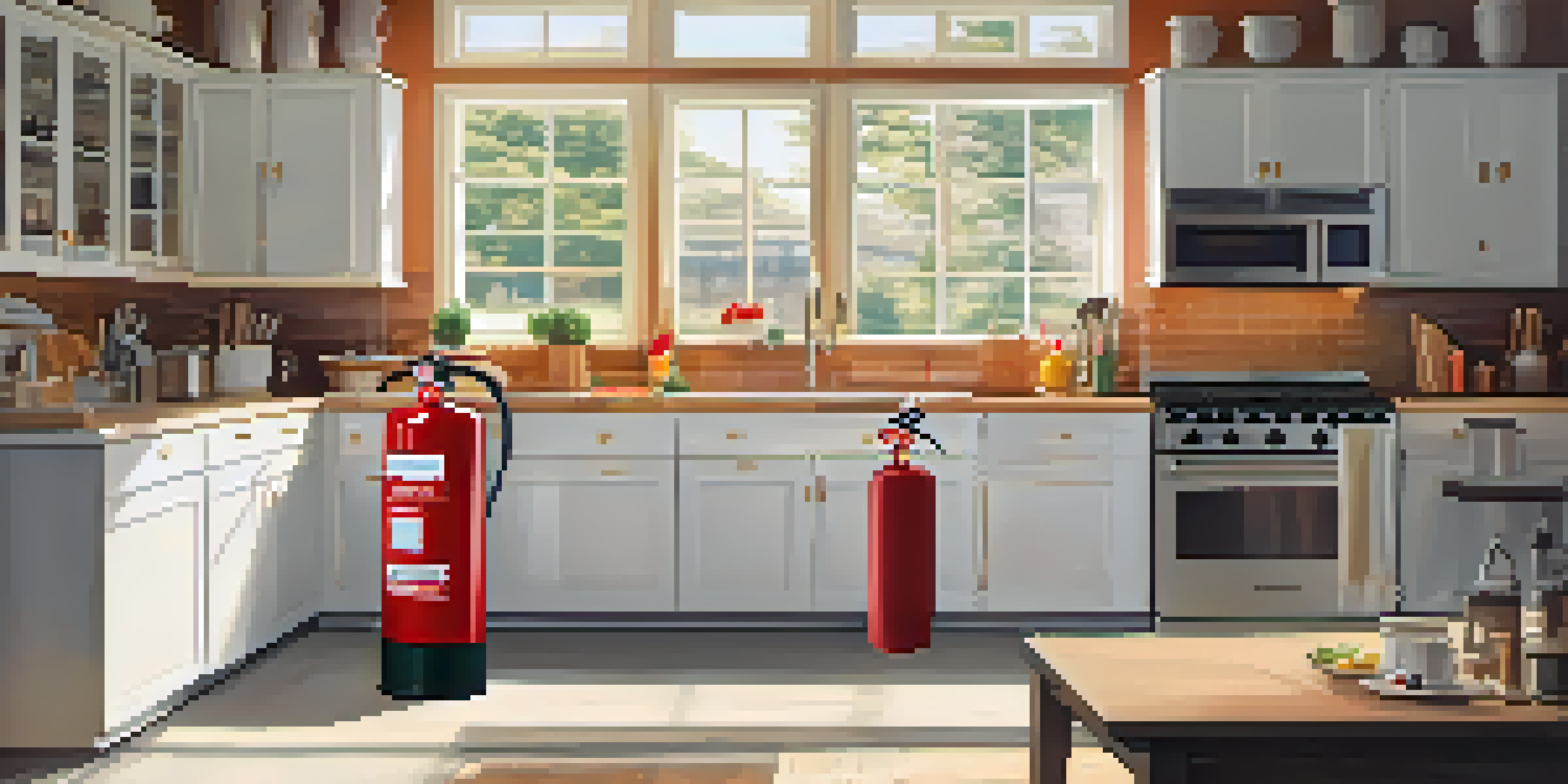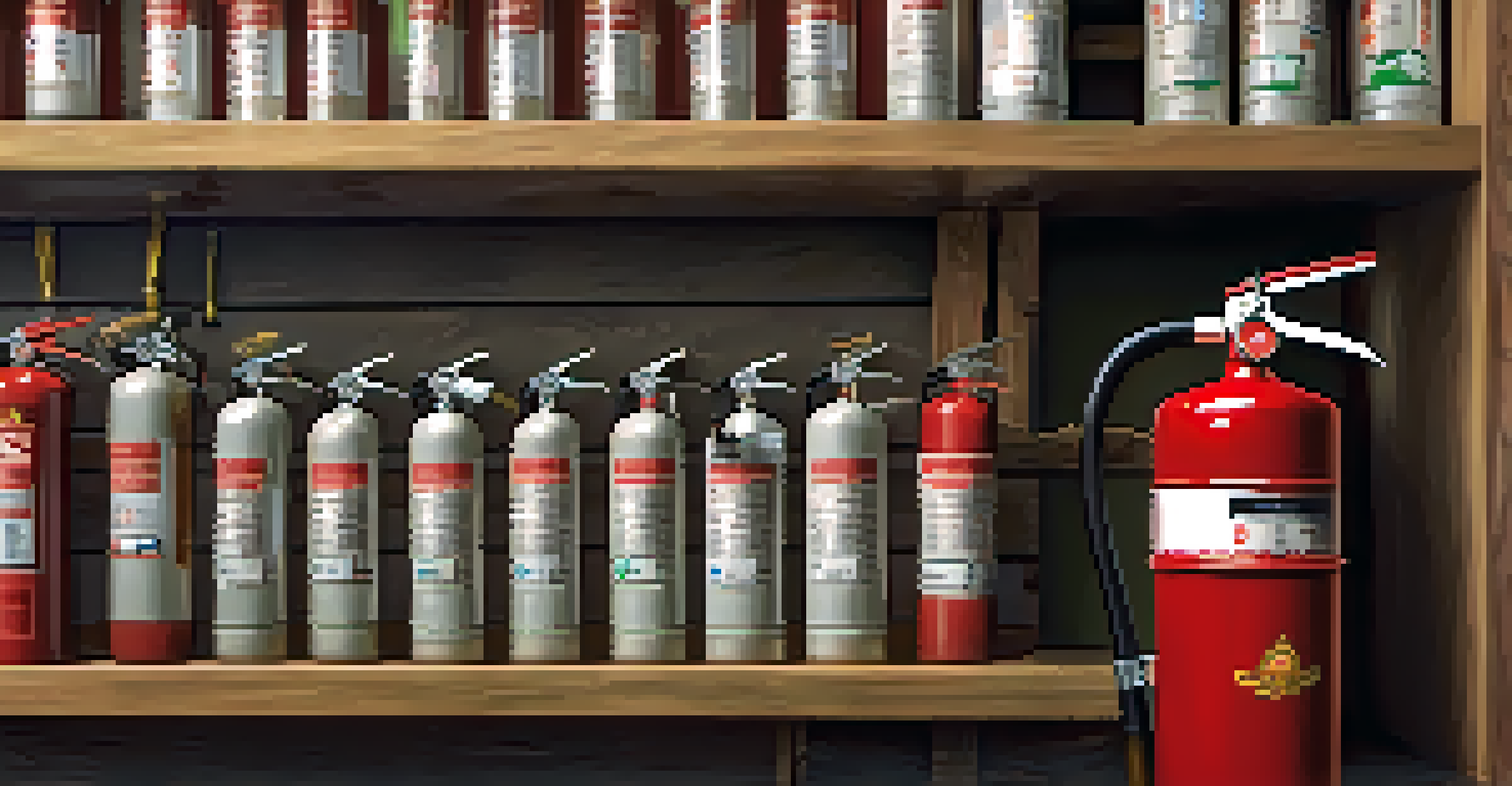How to Choose the Right Fire Extinguisher for Home

Understanding Fire Extinguisher Classes and Types
Fire extinguishers come in various classes, each designed for specific types of fires. Class A extinguishers tackle ordinary combustibles like wood and paper, while Class B is effective against flammable liquids such as gasoline. Class C is used for electrical fires, and Class D is for combustible metals, making it crucial to know which class meets your household risks.
An ounce of prevention is worth a pound of cure.
When choosing an extinguisher, consider the potential fire hazards in your home. For example, if you frequently cook, a Class K extinguisher, designed for kitchen fires, is a wise choice. Understanding these classes ensures you have the right tool to combat different fire scenarios.
Ultimately, selecting the right class of extinguisher is about being prepared. Having the appropriate extinguisher nearby increases your chances of effectively controlling a fire before it spreads.
Assessing the Size of Fire Extinguishers
Fire extinguishers come in various sizes, typically measured in pounds. Smaller extinguishers (2-5 pounds) are easy to handle and ideal for home use, while larger ones (10 pounds and up) provide more firefighting agent but can be cumbersome. It's essential to balance size with usability; after all, you want to ensure you can manage it effectively in an emergency.

Consider where you plan to place the extinguisher as well. For instance, a larger extinguisher might be more suited for a garage, while a smaller one could be perfect for a kitchen or near an exit. Accessibility is key—make sure it’s easy to reach when you need it most.
Know Fire Extinguisher Classes
Different classes of fire extinguishers are designed for specific types of fires, making it essential to choose the right one for your home.
By thoughtfully assessing size and placement, you enhance your home’s safety. A well-placed, appropriately sized extinguisher can make a significant difference in emergency situations.
Checking Fire Extinguisher Ratings and Certifications
When shopping for a fire extinguisher, look for the label indicating its rating and certifications. The National Fire Protection Association (NFPA) and Underwriters Laboratories (UL) are reputable organizations that test and certify extinguishers. A certified extinguisher not only meets safety standards but also assures you of its reliability in emergencies.
Safety isn't expensive, it's priceless.
The rating on the extinguisher tells you how effective it is against certain types of fires. For instance, a 2-A:10-B:C rating means it can handle Class A, B, and C fires, giving you a versatile option for home safety. Always choose extinguishers with higher ratings for better performance.
By prioritizing certified extinguishers, you're investing in quality. Reliable equipment can be a lifesaver when every second counts during a fire.
Understanding Fire Extinguisher Maintenance Needs
Owning a fire extinguisher comes with the responsibility of regular maintenance. Check the pressure gauge monthly to ensure it’s in the green zone, indicating it’s ready for use. Additionally, inspect for any signs of damage, such as dents or rust, which could compromise its effectiveness.
Every year, you should also perform a more thorough inspection, and most manufacturers recommend having your extinguisher serviced every 5 to 6 years. If an extinguisher is used, even partially, it should be recharged or replaced immediately. Proper maintenance can ensure your extinguisher works when you need it the most.
Regular Maintenance is Key
Maintaining your fire extinguisher through monthly checks and periodic servicing ensures it will function effectively in an emergency.
Taking care of your fire extinguisher is a simple yet crucial task. Regular checks and maintenance can help prevent a potentially disastrous situation.
Strategically Placing Fire Extinguishers in Your Home
Placement of fire extinguishers is just as vital as choosing the right one. A good rule of thumb is to have at least one extinguisher on each floor of your home, particularly near high-risk areas like the kitchen, garage, and bedrooms. This strategic placement ensures that you can quickly grab one in case of an emergency.
Make sure to mount extinguishers at a height that’s easily accessible. Adults should be able to reach them without difficulty, while children should be taught how to use them safely if they are old enough. Clear pathways to extinguishers are also crucial for quick access.
By being strategic about placement, you increase the likelihood of effectively managing a fire, providing peace of mind for you and your family.
Ensuring Everyone Knows How to Use a Fire Extinguisher
It's not enough to simply have a fire extinguisher; everyone in your household should know how to use it. Familiarize each member with the PASS technique: Pull the pin, Aim low, Squeeze the handle, and Sweep side to side. Practicing this method can make a big difference in a real-life situation where every second counts.
Consider organizing a family safety drill that includes the use of the extinguisher. This hands-on experience can build confidence and ensure everyone knows what to do in an emergency. It’s a great way to instill a sense of responsibility and preparedness.
Educate Your Household
Everyone in your home should know how to use a fire extinguisher properly to respond effectively in a crisis.
By educating your family about fire safety, you empower them to act effectively in a crisis. Knowledge is a powerful tool when it comes to fire prevention and safety.
Updating Your Fire Extinguisher as Needed
Fire extinguishers have a lifespan, so it’s essential to know when to replace yours. Generally, extinguishers should be replaced every 10 to 12 years, depending on the manufacturer’s guidelines. If yours is older than that, it’s time to invest in a new one for your home’s safety.
Even if an extinguisher is still functional, if it has been discharged, even partially, it needs to be recharged or replaced. Don’t wait until it's too late—plan for regular checks and updates to ensure you're always prepared.

By staying proactive about your fire safety equipment, you create a safer environment for your family. Regular updates on extinguishers are a simple yet effective way to enhance your home’s preparedness.